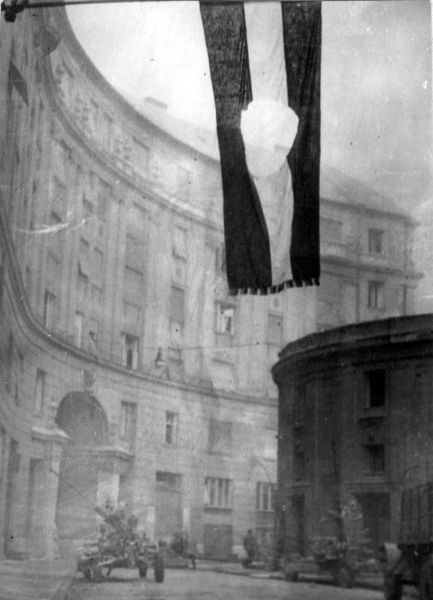Battle Of The Corvin Passage on:
[Wikipedia]
[Google]
[Amazon]
The Battle of the Corvin Passage ( hu, Corvin közi csata) was a battle fought in the
 Nicknamed 'Bajusz' for his 'Twirly' mustache,
Nicknamed 'Bajusz' for his 'Twirly' mustache,
Hungarian Revolution of 1956
The Hungarian Revolution of 1956 (23 October – 10 November 1956; hu, 1956-os forradalom), also known as the Hungarian Uprising, was a countrywide revolution against the government of the Hungarian People's Republic (1949–1989) and the Hunga ...
. It proved to be one of the most important battlegrounds during the war. A statue can be found at Corvin köz, near Corvin–negyed (Budapest Metro), to mark this important event in the Hungarian Revolution of 1956. The battle is known for starting the career of Gergely Pongrátz
Gergely Pongrátz ( Gherla, 18 February 1932 – Kiskunmajsa, 18 May 2005) was a famous veteran of the Hungarian Revolution of 1956. He was the commander of arguably the largest and perhaps the best-known group of fighters , at the Uprising's str ...
, founder of Jobbik
The Movement for a Better Hungary ( hu, Jobbik Magyarországért Mozgalom), commonly known as Jobbik (), is a conservative political party in Hungary.
Originating with radical and nationalist roots, at its beginnings, the party described itself ...
.
Prelude
Due to a lack of jobs, declining quality of life, and the failure of the Hungarian economy, an uprising occurred on October 24, 1956. The Corvin Passage was immediately recognized by the rebels as a strategic location due to its importance as a traffic junction, and its strategic value near the Kilian Barracks and the Budapest Radio Station. The Passage also provided a good defense point, with narrow streets that limited the movement of larger vehicles such as tanks and trucks.http://www.allworldwars.com/Revolutionary-Forces-of-the-Hungarian-Revolution-1956-by-Zoltan-Virag.html Figure 1.The Corvin PassageEarly battle
László Iván Kovács is said to have first fought at the Corvin Passage in October during the early stages of the Hungarian Revolution (1956). He first began demonstrating outside of a radio station and later that day used a gun on Üllői Avenue to fight against Soviet tanks. On October 26, he joined other armed revolutionaries in Corvin where he eventually became the leader of a unit of 1,000. It was here that he set up his base in Corvin's resident cinema where his successor, Gergely, also set up command. The soldiers at Corvin had already resisted a Soviet offensive on October 24 and the Soviets were later defeated, suffering heavy casualties. The Soviet strategy then was to gather intelligence and attack with a renewed offensive on October 28. To direct the offensive the Soviets appointed the leader of the 33rd Guards Mechanized Division,Gennady Ivanovich Obaturov
Gennady Ivanovich Obaturov (russian: Геннадий Иванович Обатуров; – 29 April 1996) was a Soviet Army General.
Childhood and youth
Born in a peasant family in the village of Maloe Zarecheno, then part of the Marakuli ...
who had taken part in the Budapest offensive during 1944.
However, over reliance on heavy artillery, poor intelligence and insufficient planning resulted in the failure of the offensive. On October 29, the Soviets withdrew from the city until October 31. Despite his successes as a commander, after November 1, László was replaced with Gergely for unknown reasons who continued the defense of the passage until November 9.
Under Gergely Pongrátz
 Nicknamed 'Bajusz' for his 'Twirly' mustache,
Nicknamed 'Bajusz' for his 'Twirly' mustache, Gergely Pongrátz
Gergely Pongrátz ( Gherla, 18 February 1932 – Kiskunmajsa, 18 May 2005) was a famous veteran of the Hungarian Revolution of 1956. He was the commander of arguably the largest and perhaps the best-known group of fighters , at the Uprising's str ...
fought in less harmonious circumstances than his predecessor.
Though he commanded 4,000 militia compared to his predecessors 1,000, he still had to contend with a renewed Soviet offensive which had turned back toward the city and attacked on November 5. His soldiers fought from the windows of buildings, destroying Soviet tanks with makeshift Molotovs. With these tactics, Gergely gained a degree of success destroying a reported 12 tanks and inflicting heavy casualties on the Soviets. However, under heavy Soviet artillery and mortar fire, the defense of the passage became steadily more difficult and with the desertion of 300 troops on November 6, the defense became more and more difficult until fighting against the Soviets became solely guerrilla. Then on November 9, Gergely's forces were defeated and he fled to Austria
Austria, , bar, Östareich officially the Republic of Austria, is a country in the southern part of Central Europe, lying in the Eastern Alps. It is a federation of nine states, one of which is the capital, Vienna, the most populous ...
, alongside many of other Hungarian revolutionaries. He would remain in exile until 1991.
Notes
References
{{DEFAULTSORT:Battle of the Corvin Passage Hungarian Revolution of 1956 Corvin Passage